必修4unit4语法
- 格式:ppt
- 大小:1.63 MB
- 文档页数:51

单元讲解必修四unit4 bodylanguage课本单元讲解(含课文音频):必修四Unit4 Body language_doctor今天,要和大家分享的是人教版必修四Unit4常考单词、高频短语和写作句式,并附有课文音频学起来哦!Unit4 Body language常考单词、高频短语和写作句式Ⅰ. 常考单词必背1.statementn. 陈述;说明His statement is pletely untrue.他的话完全是在撒谎。
2.greetvi.&vt. 迎接;问候I greeted her with a smile.我笑着向她致意。
(1)greet sb with... 用……迎接……;用……向某人打招呼(2)greeting n. (常用复数形式) 问候;祝贺;贺词3.representvt. 代表;象征In the western countries,V often represents victory.在西方国家,V常象征着胜利。
He represented himself as a doctor.他自称是一个医生。
[快速闪记](1)represent sth to sb 向某人说明某事,向某人传达某事represent...as... 把……描绘成……represent oneself as/to be... 自称是……(2)representative n. 代表4.curiousadj. 好奇的The children were curious to know what was happening over there.孩子们很想知道那边发生了什么事。
[快速闪记](1)be curious about 对(某事物)感到好奇be curious to do... 很想做某事;渴望做某事(2)curiously adv. 好奇地5.approachvt..&vi.接近;靠近;走近 n. 接近;方法;途径As summer approached,the weather became hotter and hotter.随着夏天的临近,天气越来越热。

Unit 4重点单词、短语、句型梳理重点单词●●greet【课文原句】There are many different ways to greet someone using words. (Page 25)【点拨】greet v. 意为"迎接;问候"。
如:He made his way through the crowd to greet us.Bill opened the door to Harold and greeted him with cries of welcome.【拓展】greeting n. 意为"问候;祝贺",是可数名词。
如:"How are you?" is a conventional greeting."Good morning, "I said, but he didn’t return the greeting.【小试牛刀】句型转换。
1. The two students exchanged greetings.= The two students ________ _______ _______.2. We sent him a message, greeting his birthday.= We _______ _______ to his birthday.Key: 1. greeted each other2. sent greetings●●function【课文原句】... the smile —its function is to show happiness and put people at ease. (Page 30)【点拨】function n. 意为"作用,功能"。
如:The machine performs a very important function in our work.【拓展】function v. 意为"起……的作用(常与as连用);运转"。

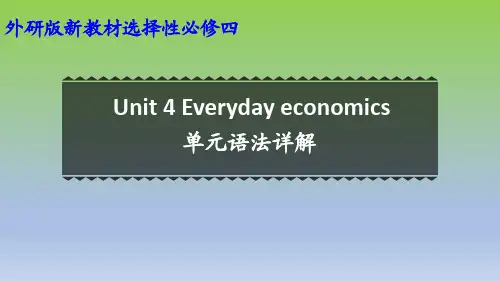
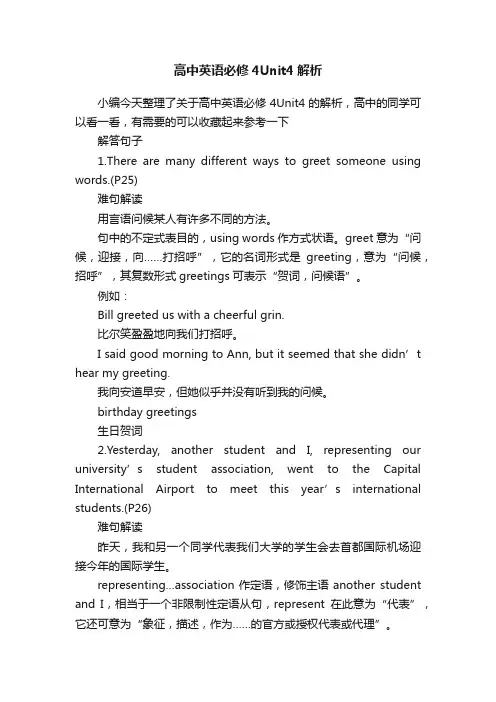
高中英语必修4Unit4解析小编今天整理了关于高中英语必修4Unit4的解析,高中的同学可以看一看,有需要的可以收藏起来参考一下解答句子1.There are many different ways to greet someone using words.(P25)难句解读用言语问候某人有许多不同的方法。
句中的不定式表目的,using words作方式状语。
greet意为“问候,迎接,向……打招呼”,它的名词形式是greeting,意为“问候,招呼”,其复数形式greetings可表示“贺词,问候语”。
例如:Bill greeted us with a cheerful grin.比尔笑盈盈地向我们打招呼。
I said good morning to Ann, but it seemed that she didn’t hear my greeting.我向安道早安,但她似乎并没有听到我的问候。
birthday greetings生日贺词2.Yesterday, another student and I, representing our university’s student association, went to the Capital International Airport to meet this year’s international students.(P26)难句解读昨天,我和另一个同学代表我们大学的学生会去首都国际机场迎接今年的国际学生。
representing…association作定语,修饰主语another student and I,相当于一个非限制性定语从句,represent在此意为“代表”,它还可意为“象征,描述,作为……的官方或授权代表或代理”。
例如:The rose represents England.玫瑰花是英格兰的象征。
The bald eagle represents the United States.秃鹰象征着美国。
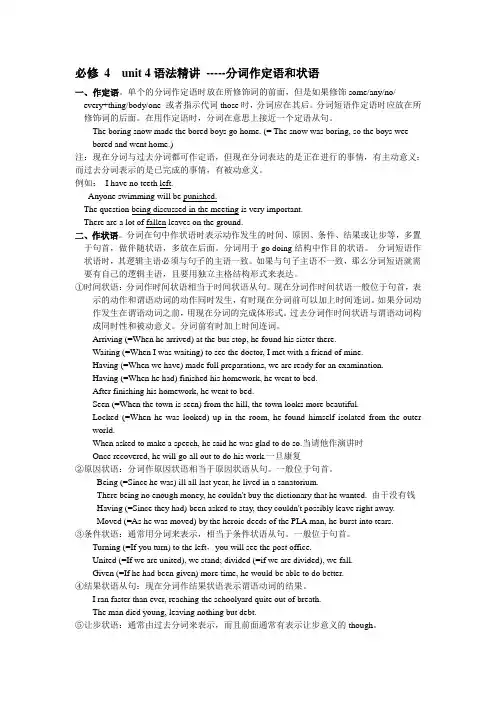
必修 4 unit 4语法精讲-----分词作定语和状语一、作定语。
单个的分词作定语时放在所修饰词的前面,但是如果修饰some/any/no/every+thing/body/one 或者指示代词those时,分词应在其后。
分词短语作定语时应放在所修饰词的后面。
在用作定语时,分词在意思上接近一个定语从句。
The boring snow made the bored boys go home. (= The snow was boring, so the boys wee bored and went home.)注:现在分词与过去分词都可作定语,但现在分词表达的是正在进行的事情,有主动意义;而过去分词表示的是已完成的事情,有被动意义。
例如:I have no teeth left.Anyone swimming will be punished.The question being discussed in the meeting is very important.There are a lot of fallen leaves on the ground.二、作状语。
分词在句中作状语时表示动作发生的时间、原因、条件、结果或让步等,多置于句首,做伴随状语,多放在后面。
分词用于go doing结构中作目的状语。
分词短语作状语时,其逻辑主语必须与句子的主语一致。
如果与句子主语不一致,那么分词短语就需要有自己的逻辑主语,且要用独立主格结构形式来表达。
①时间状语:分词作时间状语相当于时间状语从句。
现在分词作时间状语一般位于句首,表示的动作和谓语动词的动作同时发生,有时现在分词前可以加上时间连词。
如果分词动作发生在谓语动词之前,用现在分词的完成体形式。
过去分词作时间状语与谓语动词构成同时性和被动意义。
分词前有时加上时间连词。
Arriving (=When he arrived) at the bus stop, he found his sister there.Waiting (=When I was waiting) to see the doctor, I met with a friend of mine.Having (=When we have) made full preparations, we are ready for an examination.Having (=When he had) finished his homework, he went to bed.After finishing his homework, he went to bed.Seen (=When the town is seen) from the hill, the town looks more beautiful.Locked (=When he was looked) up in the room, he found himself isolated from the outer world.When asked to make a speech, he said he was glad to do so.当请他作演讲时Once recovered, he will go all out to do his work.一旦康复②原因状语:分词作原因状语相当于原因状语从句。
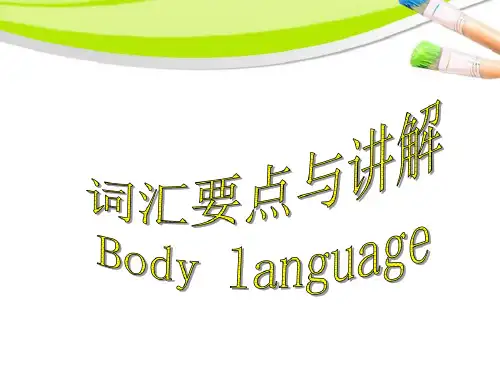
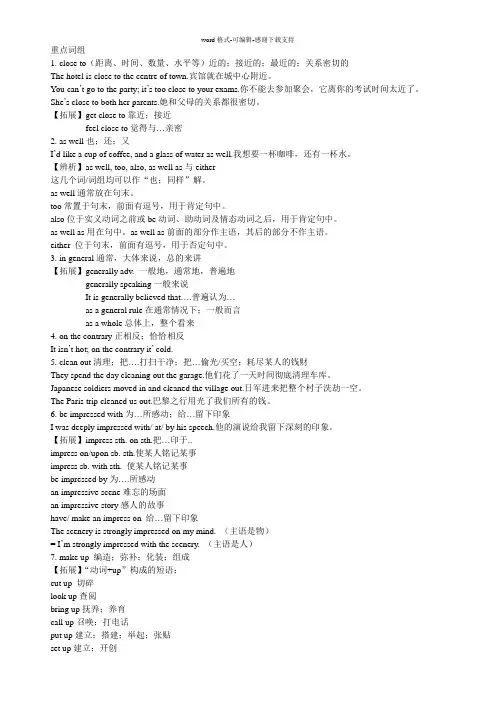
1. close to(距离、时间、数量、水平等)近的;接近的;最近的;关系密切的The hotel is close to the centre of town.宾馆就在城中心附近。
You can’t go to the party; it’s too close to your exams.你不能去参加聚会,它离你的考试时间太近了。
She’s close to both her parents.她和父母的关系都很密切。
【拓展】get close to靠近;接近feel close to觉得与…亲密2. as well也;还;又I’d like a cup of coffee, and a glass of water as well.我想要一杯咖啡,还有一杯水。
【辨析】as well, too, also, as well as与either这几个词/词组均可以作“也;同样”解。
as well通常放在句末。
too常置于句末,前面有逗号,用于肯定句中。
also位于实义动词之前或be动词、助动词及情态动词之后,用于肯定句中。
as well as用在句中。
as well as前面的部分作主语,其后的部分不作主语。
either 位于句末,前面有逗号,用于否定句中。
3. in general通常,大体来说,总的来讲【拓展】generally adv. 一般地,通常地,普遍地generally speaking一般来说It is generally believed that….普遍认为…as a general rule在通常情况下;一般而言as a whole总体上,整个看来4. on the contrary正相反;恰恰相反It isn’t hot; on the contrary it’ cold.5. clean out清理;把….打扫干净;把…偷光/买空;耗尽某人的钱财They spend the day cleaning out the garage.他们花了一天时间彻底清理车库。
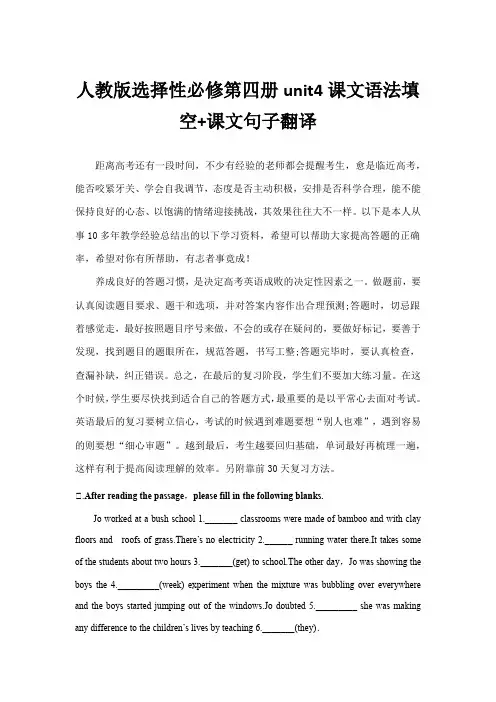
人教版选择性必修第四册unit4课文语法填空+课文句子翻译距离高考还有一段时间,不少有经验的老师都会提醒考生,愈是临近高考,能否咬紧牙关、学会自我调节,态度是否主动积极,安排是否科学合理,能不能保持良好的心态、以饱满的情绪迎接挑战,其效果往往大不一样。
以下是本人从事10多年教学经验总结出的以下学习资料,希望可以帮助大家提高答题的正确率,希望对你有所帮助,有志者事竟成!养成良好的答题习惯,是决定高考英语成败的决定性因素之一。
做题前,要认真阅读题目要求、题干和选项,并对答案内容作出合理预测;答题时,切忌跟着感觉走,最好按照题目序号来做,不会的或存在疑问的,要做好标记,要善于发现,找到题目的题眼所在,规范答题,书写工整;答题完毕时,要认真检查,查漏补缺,纠正错误。
总之,在最后的复习阶段,学生们不要加大练习量。
在这个时候,学生要尽快找到适合自己的答题方式,最重要的是以平常心去面对考试。
英语最后的复习要树立信心,考试的时候遇到难题要想“别人也难”,遇到容易的则要想“细心审题”。
越到最后,考生越要回归基础,单词最好再梳理一遍,这样有利于提高阅读理解的效率。
另附靠前30天复习方法。
Ⅰ.After reading the passage,please fill in the following blanks.Jo worked at a bush school 1._______ classrooms were made of bamboo and with clay floors and roofs of grass.There’s no electricity 2.______ running water there.It takes some of the students about two hours 3._______(get) to school.The other day,Jo was showing the boys the 4._________(week) experiment when the mixture was bubbling over everywhere and the boys started jumping out of the windows.Jo doubted 5._________ she was making any difference to the children’s lives by teaching 6._______(they).Jo and Jenny visited Tombe’s home.When they arrived at the village,Tombe’s mother who 7.________(work) in her garden,started crying “ieee ieee”.Tombe’s father led them to his house,a low bamboo hut with grass 8._______(stick) out of the roof,where they could only see a few possessions.9._____ they ate were sweet potatoes,corn and greens.That night Jo and Jenny slept on a 10._______(new) made platform.They left the village the next morning after many goodbyes and firm handshakes.1.whose2. or3. to get4. weekly5.whether6. them7. had been working8.sticking9.What 10. newlyⅠ.课文原句翻译1.与我们国家的学生不同,这些男孩不穿棉质制服,他们中的许多人也必须走很长一段路。
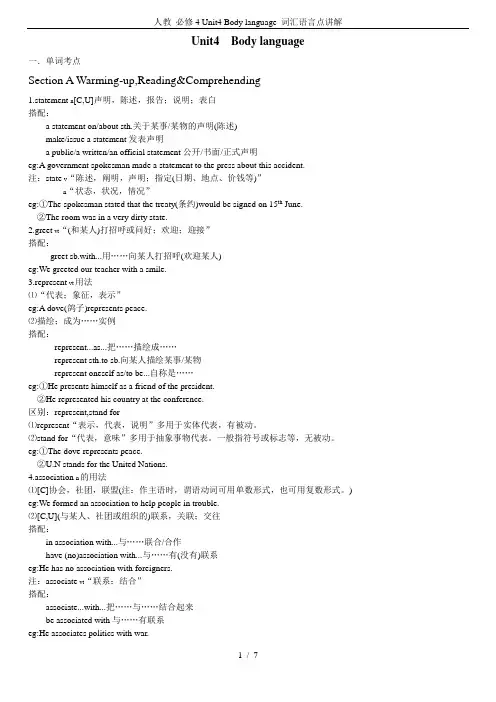
Unit4 Body language一.单词考点Section A Warming-up,Reading&Comprehending1.statement n[C,U]声明,陈述,报告;说明;表白搭配:a statement on/about sth.关于某事/某物的声明(陈述)make/issue a statement发表声明a public/a written/an official statement公开/书面/正式声明eg:A government spokesman made a statement to the press about this accident.注:state v“陈述,阐明,声明;指定(日期、地点、价钱等)”“状态,状况,情况”neg:①The spokesman stated that the treaty(条约)would be signed on 15th June.②The room was in a very dirty state.2.greet vt“(和某人)打招呼或问好;欢迎;迎接”搭配:greet sb.with...用……向某人打招呼(欢迎某人)eg:We greeted our teacher with a smile.3.represent vt用法⑴“代表;象征,表示”eg:A dove(鸽子)represents peace.⑵描绘;成为……实例搭配:represent...as...把……描绘成……represent sth.to sb.向某人描绘某事/某物represent oneself as/to be...自称是……eg:①He presents himself as a friend of the president.②He represented his country at the conference.区别:represent,stand for⑴represent“表示,代表,说明”多用于实体代表,有被动。
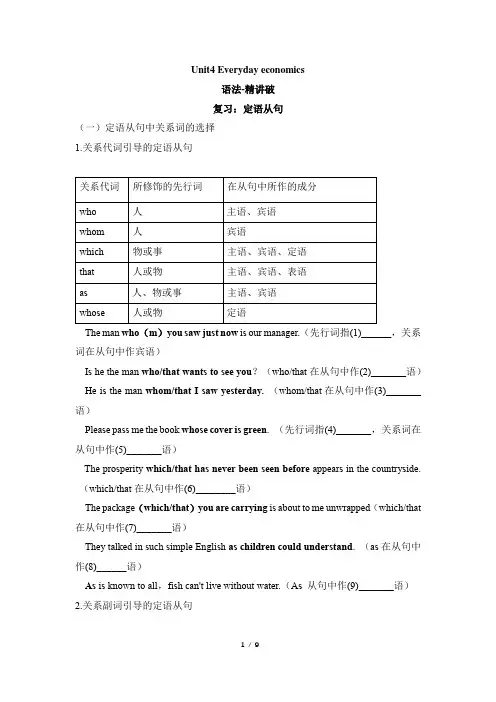
Unit4 Everyday economics语法-精讲破复习:定语从句(一)定语从句中关系词的选择1.关系代词引导的定语从句The man who(m)you saw just now is our manager.(先行词指(1)______,关系词在从句中作宾语)Is he the man who/that wants to see you?(who/that在从句中作(2)_______语)He is the man whom/that I saw yesterday. (whom/that在从句中作(3)_______语)Please pass me the book whose cover is green. (先行词指(4)_______,关系词在从句中作(5)_______语)The prosperity which/that has never been seen before appears in the countryside.(which/that在从句中作(6)________语)The package(which/that)you are carrying is about to me unwrapped(which/that 在从句中作(7)_______语)They talked in such simple English as children could understand. (as在从句中作(8)______语)As is known to all,fish can't live without water.(As 从句中作(9)_______语)2.关系副词引导的定语从句关系副词when、where、why的含义相当于“介词+which”结构,因此常常和“介词+ which"结构交换使用。
There are occasions (10)________(on which)one must yield.Beijing is the place where (11)________ I was born.Is this the reason why((12)________ which)he refused our offer?(二)定语从句的分类1.根据定语从句与先行词之间关系的紧密程度,可将定语从句分为限制性定语从句和非限制性定语从句。
1. 学习句型,理解句型的含义。
2. 正确地运用句型,并能灵活地用于作文。
3. 掌握并能够熟练运用不定式放在序数词、最高级以及一些特定词之后作定语的用法。
重点:The first person to arrive was Tony Garcia from Colombia, closely followed by Julia Smith from Britain.第一个到达的是从哥伦比亚来的托尼·加西亚,随后紧跟着的是英国的朱莉娅·史密斯。
Not all cultures greet each other the same way, nor are they comfortable in the same way with touching or distance between people.各种文化背景下人们互相问候的方式不尽相同,身体接触的程度和相互间的距离也并不一样。
难点:so, neither, nor位于句首构成部分倒装的用法以及几个结构的用法区别。
【句型学习】1. The first person to arrive was Tony Garcia from Colombia, closely followed by Julia Smith from Britain.第一个到达的是从哥伦比亚来的托尼·加西亚,随后紧跟着的是英国的朱莉娅·史密斯。
本句中to arrive是不定式作定语,修饰the first person。
当名词前有only, last, next等序数词或形容词最高级修饰时,常用不定式作定语。
(1)当中心词是序数词或被序数词、形容词最高级,如next, only, last等限定时,常用不定式作后置定语。
(2)动词不定式作定语用来修饰的词是抽象名词,常见的有:ability, chance, ambition, offer, anxiety, answer, reply, attempt, belief等。